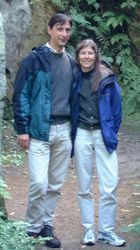The next big answers about dinosaurs is predicted to come from some very small remains."Molecules are fossils, too," said Dr. Peggy Ostrom from the Dept. of Zoology at Michigan State University. "We've shown that proteins survive in very old fossils, and proteins can tell us about diseases, about where prehistoric animals fit in the food chain, what they ate and who they are related to."
Ostrom joins six other scientists engaged in various versions of CSI: Jurassic Park. The symposium, "New Approaches to Paleontological Investigation," at the American Association for the Advancement of Science annual meeting Friday explores cutting edge technology used to divine new information from ancient bits of bone and tissue.
One of the field's hottest topics is whether proteins and DNA survive the test of time. Ostrom is putting her bet on proteins and is working with an international team from Michigan, the Smithsonian and York and Cardiff Universities in the UK to track down these building blocks of bone.
"It just takes two or three pinches of bone powder to find molecular evidence," Ostrom said.
 "We have protein sequences from material believed to be in range of half a million years old. We are carefully working our way back in time."
"We have protein sequences from material believed to be in range of half a million years old. We are carefully working our way back in time." She said it appears some proteins can endure longer than DNA. In a recent study Ostrom's students found that a protein in bone in an environment void of oxygen (say, if it's been resting in a swamp) can last for 200 hours at temperatures of 100 degrees Celsius.
"If we have a protein sequence from bone, we can tell if the material is an original part of the organism that will provide interesting information about its past. We can know where it came from." Ostrom said. "Our goal is to use a variety of technologies new to paleontology to develop a deeper understanding of prehistoric life -- and everyone dreams of embellishing our understanding of dinosaurs."
Note: I’ll be posting more from this conference over the next 48 hours as the various talks are given and the embargos come off the press releases.
Dr. Ostrom (above, with her husband, Dr. Ostrom) and the palaeoblogger are collaborating on several projects right now looking at the information that can be derived from the isotopic make up of various dinosaur bones. I’ll be visiting Peggy’s lab in late April and giving a couple of talks on campus while I'm there.